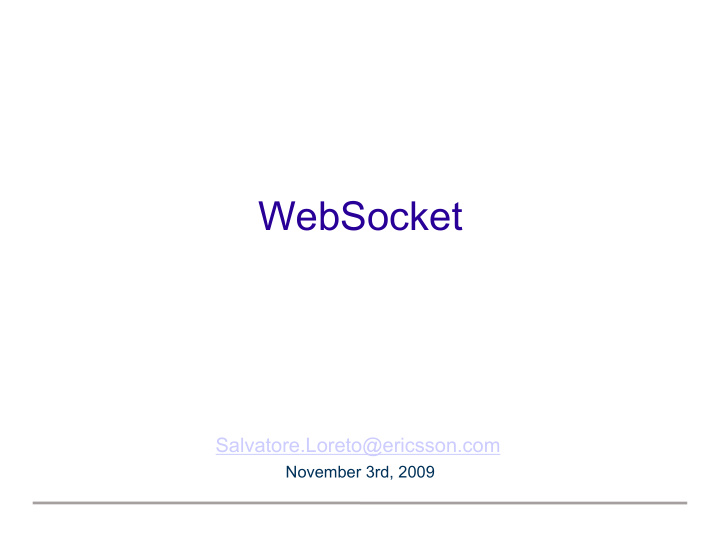



WebSocket Slide title APITALS 50 pt e subtitle 32 pt Salvatore.Loreto@ericsson.com November 3rd, 2009
WebSocket Defines full-duplex communications using a single TCP connection (compared to Comet technologies) It is a mechanism for browser-based applications Slide title that need two-way communication with servers APITALS 50 pt e subtitle 32 pt
WebSocket WS is intended to be as close as possible to just exposing raw TCP/IP to JavaScript as possible given the constraints of the Web. Slide title It is just a layer on top of TCP/IP that adds APITALS 50 pt – Web “origin”-based security model for browser e subtitle – Addressing and protocol naming mechanism to 32 pt support multiple services on one port and multiple host names on one IP address – Layers a framing mechanism on top of TCP
WebSocket (Handshake) WebBrowser (Client) ---> Server The first 3 lines are GET /text HTTP/1.1\r\n hard-coded Upgrade: WebSocket\r\n (case and order matters) Connection: Upgrade\r\n Host: example.com\r\n The remainder are WebSocket-Origin: http://example.com\r\n Slide title Unordered ASCII APITALS WebSocket-Protocol: sample\r\n Case-insensitve set of fields 50 pt …\r\n WebBrowser(Client) <--- Server e subtitle HTTP/1.1 101 Web Socket Protocol Handshake\r\n 32 pt Upgrade: WebSocket\r\n Connection: Upgrade\r\n WebSocket-Origin: http://example.com\r\n WebSocket-Location: ws://example.com/demo\r\n WebSocket-Protocol: sample\r\n …\r\n
HTTP Upgrade header The Upgrade header provides the sender of a message with a means of broadcasting the desire to use another, perhaps completely different, protocol If the server is capable, it can send an appropriate response Slide title letting the client know that it is okay to use the new protocol. APITALS 50 pt This provides an efficient way to move to other protocols. e subtitle When a server sends a 101 Switching Protocols response, it 32 pt must include this header.
WebSocket (connection) The WebSoket by default uses port 80 for regular Websocket connection; Port 80 traffic, however, will often be intercepted by HTTP proxies, which can lead to the connection Slide title failing to be established. APITALS 50 pt The most realibe method, therefore, is to use TLS e subtitle encryption and port 443 to connect directly to a 32 pt WebSocket server. More secure, but computationally expansive.
WebSocket (tunnel) If the user agent is configured to use an HTTP proxy, then – the user agent sends a CONNECT request to the proxy. The CONNECT method asks the proxy to Slide title open a TCP connection APITALS 50 pt CONNECT example:80 HTTP/1.1 Host: example.com e subtitle – Once the TCP connection is established, the proxy 32 pt notifies the user agent by sending HTTP/1.1 200 Connection Established response.
WebSocket (tunnel) – At this point, the tunnel is set up. Any data sent by the user agent over the HTTP tunnel will be relayed directly to the outgoing TCPconnection; Slide title APITALS and any data sent by the server will be relayed to the user 50 pt agente over the HTTP tunnel. e subtitle 32 pt
WebSocket (Data transfer) If the handshake was successful, then the data transfer starts. This is a two-way communication channel where each side can, indeendently from the other, send data Data is sent in the form of UTF-8 text. Slide title APITALS Each frame of data starts with 0x00 byte and ends with a 50 pt 0xFFbyte, with the UTF- text in between. e subtitle The protocol is designed to support other frame types in future. 32 pt Instead of the 0x00 byte, other bytes might in future be defined. Frames denoted by bytes that have the high bit set (0x80 to 0xFF) have a leading length indicator
WebSocket (Data transfer) Text Frames use terminator – \x00Hello, WebSocket\0xff Slide title Binary Frames use length prefix APITALS 50 pt – \x80\0x10Hello, WebSocket e subtitle 32 pt Text and binary frames on same WebSocket
WebSocket API WebSocket API enables Web pages to use the WebSockets protocol for two-way communication with a remote host. WebSocket scheme: ws, wss var location = “ws://www.example.org/text”; Slide title var socket = new WebSocket(location); APITALS 50 pt Creating a WebSocket instance socket. onopen = function(event) { e subtitle socket. postMessage (“Hello, WebSocket”); } 32 pt socket. onmessage =function(event) { alert(event.data); } socket. onclose = function(event) { alert(“closed”); }
WebSocket Implementation Slide title APITALS 50 pt WebSocket class corresponds to WebSocket DOM interface e subtitle WebSocketChannelClient 32 pt notifies events to its client WebSocketChannel performs WS WebSocketChannel performs WS handshaking handshaking SocketStreamHandleClient is SocketStreamHandleClient is SocketStreamHandle manages a used to notify to its client used to notify to its client Socket stream in platform specific way
References The Web Sockets API: http://dev.w3.org/html5/websockets/ The Web Socket protocol: http://tools.ietf.org/html/draft-hixie-thewebsocketprotocol-54 Slide title APITALS 50 pt Best Practices for the Use of Long Polling and Streaming in Bidirectional HTTP: e subtitle http://www.ietf.org/id/draft-loreto-http-bidirectional-01.txt 32 pt Bidirectional communication for hypertext (HyBi) BoF: http://trac.tools.ietf.org/bof/trac/wiki/HyBi
Recommend
More recommend